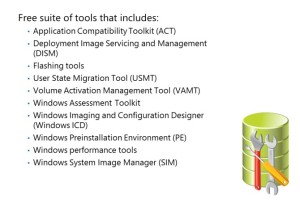This post by David Papkin is Deploying Windows 10 in the Enterprise
New operating systems contain new features and capabilities, which encourage Organizations to upgrade usually in a planned systematic manner.
Windows 10 improves the deployment process with the use of tools and procedures.
- New deployment. This clean install offers maximum comparability although all Apps must be reinstalled.
- In-place upgrades from Windows 7 & 8.x to Windows 10. This preserves user data although there can be comparability issues.
- Windows ICD (Imaging and Configuration Designer ( tool from the Windows ADK (Automated Deployment Kit).
The Microsoft Windows ADK includes:
- The Windows Assessment Toolkit and the Windows Performance Toolkit to assess the quality and performance of systems or components.
- Several deployment tools such as WinPE, Windows Imaging and Configuration Designer (Windows ICD), and other tools to customize and deploy Windows 10 images.
Some deployment methods are sometimes referred to as lite-touch installations (LTIs) and zero-touch installations (ZTIs). LTIs require a small amount of user or administrator intervention, whereas ZTIs do not—they are completely automatic. For example, in LTIs, the user or administrator has to turn on the device and press a function key to help the installation get started, In ZTI, you can use Wake On LAN technology to turn on a device and push the operating system to it. Do not associate LTIs with MDT and ZTIs with Configuration Manager. The difference between these two methods is not the tool that is used, but how much intervention they require.
https://msdn.microsoft.com/library/windows/hardware/dn916105(v=vs.85).aspx
This concludes This post by David Papkin is Deploying Windows 10 in the Enterprise.
